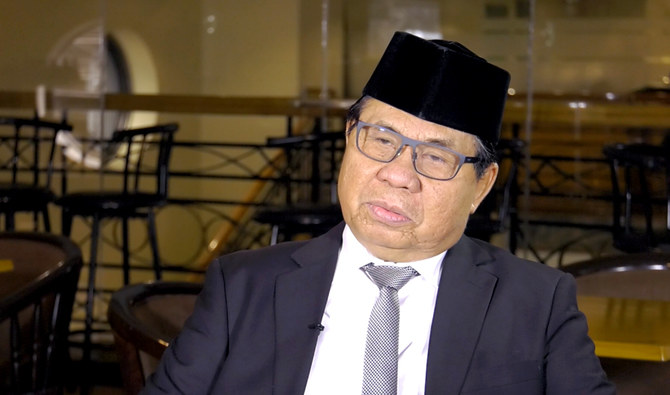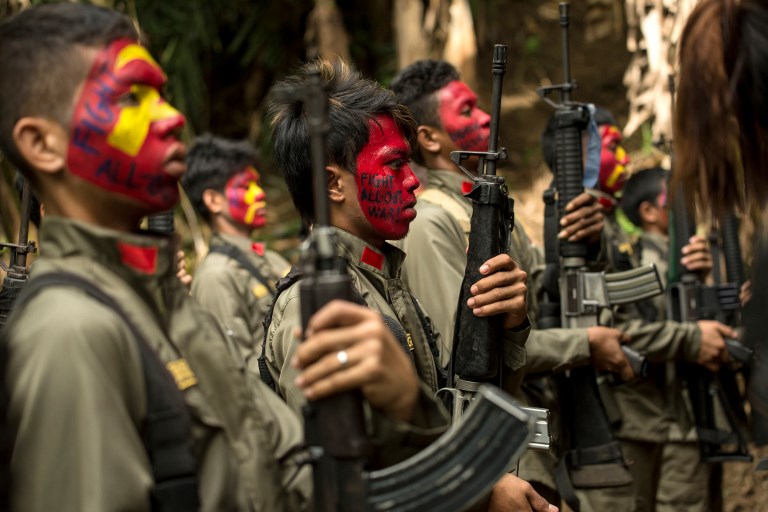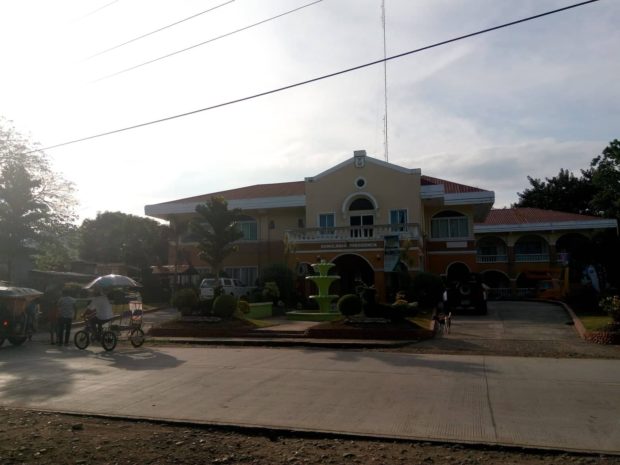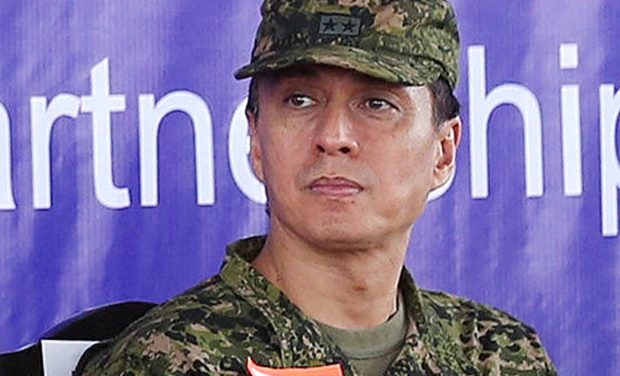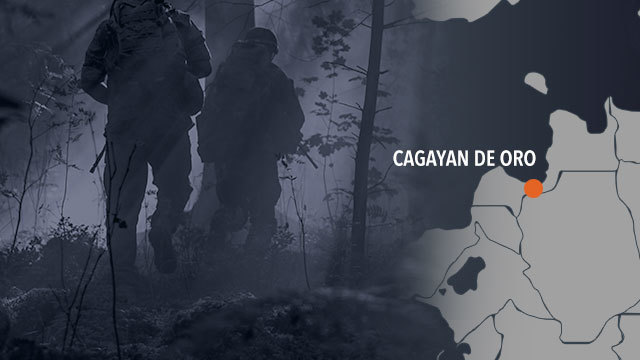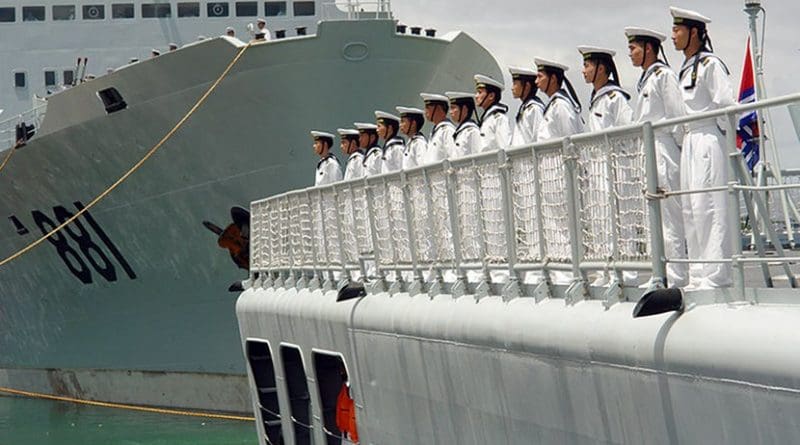
Sailors from China's Navy man the rails aboard the destroyer Qingdao (DDG 113). U.S. Navy photo by Mass Communication Specialist Joe Kane
After fighting with Vietnam for the control of the South China Sea in areas disputed by both the countries, China now is engaged in fighting with the Philippines over the same reason. After Chinese ships came close to Vietnamese vessels in areas claimed by Vietnam, Chinese warships were alleged to have been passing through the Sibutu Strait in Mindanao off the coast of Tawi-Tawi with inactive Automatic Identification Systems (AIS), despite objections made by the Philippine authorities.
The Philippines Defence Secretary Delfin Lorenzana called the Chinese actions in the West Philippine Sea, the way China’s militia took over Scarborough Shoal as “bullying”. He questioned to the credibility of the remarks made by the Chinese ambassador Zhao Jianhua that China is a peace-loving nation and that it would not start a war or confrontation in the South China Sea, a potential “flashpoint” for armed conflict. Philippines feel that China’s words do not match with its actions in the West Philippine Sea (WPS).
In maritime matters, it is common sense that if the AIS are shut off, the intention is to hide the presence of the vessel. Philippines reasoned out therefore that Chinese ships should not deactivate their AIS when passing through Philippine waters. Even if the Philippine radar cannot detect because the AIS are deactivated, the vessels are still visible to the naked eye because the Strait is very narrow.
According to Lorenzana, the Chinese ships had passed through the Sibutu Strait four times since last February and as per international law, if warships intended to pass through Philippine waters, they needed to inform local authorities. It is believed that there exist a verbal agreement between President Rodrigo Duterte and Chinese President Xi Jinping allowing the Chinese to fish in the West Philippine Sea but no such written document is available and no one know what understanding was reached between Duterte and Xi.
It is mysterious that as per the understanding that Duterte had with Xi, the Chinese PLA Navy conducted two goodwill visits to the Philippines. In January 2019, a task force, consisting of two frigates and a replenishment ship docked in Manila for a four-day visit to the country. These send confusing signals to the ASEAN partners having similar issue with China.
To add further to the complexities, 113 Chinese fishing vessels were spotted “swarming” Pag-asa island, Philippine-administered Island in South China Sea, between July 24 and 25. According to Foreign Affairs Secretary Teodoro Locsin, the information was based on “military intelligence”. Though Locsin was in Bangkok, he was ambiguous saying that the government was unsure on the motivations of the Chinese vessels, though he recommended his government to file protest against China. Pag-asa, also known as Thitu, is the second-largest naturally occurring landmass in the Spratly archipelago in the South China Sea.
As is well known by now that Chinese strategy has been to divide the 10-member grouping of the ASEAN, which is why a mutually-agreed upon target of three years to hammer out a Code of Conduct (COC) to regulate actions in the South China Sea has not been possible and the formidable differences on how to settle disputes continue to exist. Such a strategy suits China well.
When top diplomats from the Asia-Pacific region gathered in Bangkok on 30 July to discuss issues of common concern to the area, including security on the Korean Peninsula and China’s territorial claims in the South China Sea, there was little optimism in the horizon that anything concrete shall emerge. Being hosted by Thailand as chair of the 10-member grouping, the gathering had 27 meetings in which 31 countries and alliances participated. Though the core ASEAN Foreign Ministers Meeting brought together the group’s top diplomats, they were overshadowed by the big power players in the adjunct meetings, such as the ASEAN Regional Forum and the East Asia Foreign Ministers’ Meeting. India was represented by Foreign Minister S Jaishankar to participate in the ASEAN-India Ministerial Meeting, the 9th East Asia Summit Foreign Ministers’ Meeting, the 26th ASEAN Regional Forum and the 10th Mekong Ganga Cooperation Ministerial meeting.
The heavy-hitters in Bangkok included the US Secretary of State Mike Pompeo, Chinese Foreign Minister Wang Yi and Russian Foreign Minister Sergey Lavroc. Other ASEAN dialogue partners included Australia, India, the European Union, Japan and South Korea. Despite much hype, not much progress could be made on the COC. Even when clinched, the final output might not even be a legally-binding document, which means that the COC will be just as ineffective as the present Declaration of Conduct. China, which proposed the three-year timetable starting in 2019, has refused to join a binding COC.
This three-year time frame allows China enough time to continue with its militarization of disputed territories in the South China Sea. The flashpoints are becoming more serious and the perceptions of threats –some real, some unreal – just do not go away but continue to trouble the stakeholders. Even if talks are going on at various levels and forum, it is just like going one step forward but two steps backward, with no solution in sight.
It is difficult to read the mind of President Duterte. China has overlapping claims in the resource-rich maritime area with Vietnam, Philippines, Malaysia, Brunei and Taiwan, which covers more than three million square kilometres. The Philippines won in 2016 an arbitration case before the Permanent Court of Arbitration (PCA) against China’s nine-dash line claim over almost the entire South China Sea. After coming to power, President Duterte has time and again reiterated that Manila and Beijing can settle the issue more effectively through diplomatic negotiations and has set aside the 2016 decision. He has also repeated many times that he will not risk a war with China over their territorial dispute.
It was because of such reason, Zhao felt emboldened to say that China is a peace-loving nation and will not start a war or confrontation in the South China Sea. He further justified that China develops its military entirely for the purpose of self-defense.
But realities are different. China’s stance and Philippines’ ambivalence brings in the issue of the ASEAN’s centrality under question. Vietnam that fiercely opposes the Chinese maritime advance in areas falling under its EEZ, needs friends within the ASEAN and beyond. Philippines’s stance could frustrate such a possibility.
It may be recalled that in April, Chinese fishermen drove Filipino fishermen away from the shoal as wooden ships that bore China’s flag harvested giant clams. In June, a Chinese vessel hit a Filipino fishing boat leaving 22 crewmen adrift in the open sea for hours until they were rescued by Vietnamese fishermen. The incident triggered anger at the administration’s timid response. The mild response of the Philippines encourages China to indulge in what it is doing undeterred.
However, popular opinion in the Philippines is growing against China. There has been low trust rating in local opinion polls in recent times compared with those of the US, a treaty ally of the Philippines. As the world’s second-biggest economy, China claims that it upholds freedom of navigation and overflight because nearly 75 percent of its imported and exported goods and nearly 80 percent of its imported oil and gas transit through the South China Sea. Yet, China is not shy of creating problem even though it could hurt its economy.
In 2012 when China took over the Scarborough Shoal following standoff and showing its “bullying” tactics, the US brokered a deal for the simultaneous withdrawal of Chinese and Philippine ships from the vast fishing shoal, but Beijing reneged on its promise. This prompted Manila to bring its dispute with China to international arbitration the following year. Though Manila won in 2016 a verdict in its favour with the tribunal invalidating China’s “historic claims” to virtually the entire South China Sea based on the 1982 UN Convention on the Law of the Sea, the lack of enforcing power by the tribunal led Beijing to reject the verdict with contempt. After Duterte came to power in 2016, he revived ties with China and refused to immediately seek Chinese compliance to the arbitration ruling. Instead, he prioritized seeking Chinese infrastructure funds and investment, ignoring criticism from ASEAN partners for his China-friendly approach.
So, what did Bangkok summit achieve? Though the joint communiqué issued on July 31 touched upon a host of issues, the most innocuous one was on the stance on the South China Sea. It mentioned the often repeated promise of “maintaining peace, security, stability, safety and freedom of navigation in and overflight above the South China Sea and recognized the benefits of having the South China Sea as a sea of peace, stability and prosperity”. It also “emphasized the importance of non-militarization and self-restraint in the conduct of all activities by claimants and all other states, including those mentioned in the DOC that could further complicate the situation and escalate tensions in the South China Sea”. Given China’s continuous aggressive posture in the South China Sea, these pronouncements do not make sense as parties involved in this do not respect what is agreed upon.
Notwithstanding these customary statements, ASEAN’s concern on Beijing’s expansive territorial claims in the South China Sea remains. The dispute is long-running with periodic flare-up. In particular Vietnam is quite vocal against China violating its sovereignty by interfering with offshore oil and gas activities in disputed waters. Given the non-cooperation by some ASEAN member nations, Vietnam has to operate outside the conventional ASEAN framework by forming a de facto maritime bloc with Indonesia and the Philippines. India should not be found wanting to extending hands of support as it has its own maritime interests in areas of South China Sea claimed by Vietnam. Moreover India’s naval capability is strong enough to intervene to restore maritime order if needed.
Beijing is aware that all members of the ASEAN grouping are not always on the same page on all the issues and wishes to operate by consensus. This means that a single member can exercise veto over the group’s decisions and declarations. Since China has friends in Laos and Cambodia and others are reluctant to defy, China always enjoys an edge to impose its will on others in the region. That is why China urged non-Asian nations to avoid showing “distrust” and division over contested seas even before Pompeo was to arrive in Bangkok. This was an indirect indictment of Chinese disapproval of many of Trump’s policies for the region. With the unfolding of big power rivalry, Beijing’s military ambitions and Trump’s assertion to play a key role as an Asia-Pacific power could make the situation in the Indo-Pacific region messy. As a matter of fact, China is against non-regional countries, principally aimed at the US, to desist from influencing an issue concerning its “neighbourhood”, demonstrating thereby that ASEAN is its neighbor with whom it would deal bilaterally.
[Dr. Rajaram Panda, former Senior Fellow at IDSA, New Delhi, and until recently ICCR Chair Professor at Reitaku University, Japan, is at present Lok Sabha Research Fellow, Parliament of India. E-mail: rajaram.panda@gmail.com]
https://www.eurasiareview.com/05082019-chinese-design-in-south-china-sea-analysis/
After fighting with Vietnam for the control of the South China Sea in areas disputed by both the countries, China now is engaged in fighting with the Philippines over the same reason. After Chinese ships came close to Vietnamese vessels in areas claimed by Vietnam, Chinese warships were alleged to have been passing through the Sibutu Strait in Mindanao off the coast of Tawi-Tawi with inactive Automatic Identification Systems (AIS), despite objections made by the Philippine authorities.
The Philippines Defence Secretary Delfin Lorenzana called the Chinese actions in the West Philippine Sea, the way China’s militia took over Scarborough Shoal as “bullying”. He questioned to the credibility of the remarks made by the Chinese ambassador Zhao Jianhua that China is a peace-loving nation and that it would not start a war or confrontation in the South China Sea, a potential “flashpoint” for armed conflict. Philippines feel that China’s words do not match with its actions in the West Philippine Sea (WPS).
In maritime matters, it is common sense that if the AIS are shut off, the intention is to hide the presence of the vessel. Philippines reasoned out therefore that Chinese ships should not deactivate their AIS when passing through Philippine waters. Even if the Philippine radar cannot detect because the AIS are deactivated, the vessels are still visible to the naked eye because the Strait is very narrow.
According to Lorenzana, the Chinese ships had passed through the Sibutu Strait four times since last February and as per international law, if warships intended to pass through Philippine waters, they needed to inform local authorities. It is believed that there exist a verbal agreement between President Rodrigo Duterte and Chinese President Xi Jinping allowing the Chinese to fish in the West Philippine Sea but no such written document is available and no one know what understanding was reached between Duterte and Xi.
It is mysterious that as per the understanding that Duterte had with Xi, the Chinese PLA Navy conducted two goodwill visits to the Philippines. In January 2019, a task force, consisting of two frigates and a replenishment ship docked in Manila for a four-day visit to the country. These send confusing signals to the ASEAN partners having similar issue with China.
To add further to the complexities, 113 Chinese fishing vessels were spotted “swarming” Pag-asa island, Philippine-administered Island in South China Sea, between July 24 and 25. According to Foreign Affairs Secretary Teodoro Locsin, the information was based on “military intelligence”. Though Locsin was in Bangkok, he was ambiguous saying that the government was unsure on the motivations of the Chinese vessels, though he recommended his government to file protest against China. Pag-asa, also known as Thitu, is the second-largest naturally occurring landmass in the Spratly archipelago in the South China Sea.
As is well known by now that Chinese strategy has been to divide the 10-member grouping of the ASEAN, which is why a mutually-agreed upon target of three years to hammer out a Code of Conduct (COC) to regulate actions in the South China Sea has not been possible and the formidable differences on how to settle disputes continue to exist. Such a strategy suits China well.
When top diplomats from the Asia-Pacific region gathered in Bangkok on 30 July to discuss issues of common concern to the area, including security on the Korean Peninsula and China’s territorial claims in the South China Sea, there was little optimism in the horizon that anything concrete shall emerge. Being hosted by Thailand as chair of the 10-member grouping, the gathering had 27 meetings in which 31 countries and alliances participated. Though the core ASEAN Foreign Ministers Meeting brought together the group’s top diplomats, they were overshadowed by the big power players in the adjunct meetings, such as the ASEAN Regional Forum and the East Asia Foreign Ministers’ Meeting. India was represented by Foreign Minister S Jaishankar to participate in the ASEAN-India Ministerial Meeting, the 9th East Asia Summit Foreign Ministers’ Meeting, the 26th ASEAN Regional Forum and the 10th Mekong Ganga Cooperation Ministerial meeting.
The heavy-hitters in Bangkok included the US Secretary of State Mike Pompeo, Chinese Foreign Minister Wang Yi and Russian Foreign Minister Sergey Lavroc. Other ASEAN dialogue partners included Australia, India, the European Union, Japan and South Korea. Despite much hype, not much progress could be made on the COC. Even when clinched, the final output might not even be a legally-binding document, which means that the COC will be just as ineffective as the present Declaration of Conduct. China, which proposed the three-year timetable starting in 2019, has refused to join a binding COC.
This three-year time frame allows China enough time to continue with its militarization of disputed territories in the South China Sea. The flashpoints are becoming more serious and the perceptions of threats –some real, some unreal – just do not go away but continue to trouble the stakeholders. Even if talks are going on at various levels and forum, it is just like going one step forward but two steps backward, with no solution in sight.
It is difficult to read the mind of President Duterte. China has overlapping claims in the resource-rich maritime area with Vietnam, Philippines, Malaysia, Brunei and Taiwan, which covers more than three million square kilometres. The Philippines won in 2016 an arbitration case before the Permanent Court of Arbitration (PCA) against China’s nine-dash line claim over almost the entire South China Sea. After coming to power, President Duterte has time and again reiterated that Manila and Beijing can settle the issue more effectively through diplomatic negotiations and has set aside the 2016 decision. He has also repeated many times that he will not risk a war with China over their territorial dispute.
It was because of such reason, Zhao felt emboldened to say that China is a peace-loving nation and will not start a war or confrontation in the South China Sea. He further justified that China develops its military entirely for the purpose of self-defense.
But realities are different. China’s stance and Philippines’ ambivalence brings in the issue of the ASEAN’s centrality under question. Vietnam that fiercely opposes the Chinese maritime advance in areas falling under its EEZ, needs friends within the ASEAN and beyond. Philippines’s stance could frustrate such a possibility.
It may be recalled that in April, Chinese fishermen drove Filipino fishermen away from the shoal as wooden ships that bore China’s flag harvested giant clams. In June, a Chinese vessel hit a Filipino fishing boat leaving 22 crewmen adrift in the open sea for hours until they were rescued by Vietnamese fishermen. The incident triggered anger at the administration’s timid response. The mild response of the Philippines encourages China to indulge in what it is doing undeterred.
However, popular opinion in the Philippines is growing against China. There has been low trust rating in local opinion polls in recent times compared with those of the US, a treaty ally of the Philippines. As the world’s second-biggest economy, China claims that it upholds freedom of navigation and overflight because nearly 75 percent of its imported and exported goods and nearly 80 percent of its imported oil and gas transit through the South China Sea. Yet, China is not shy of creating problem even though it could hurt its economy.
In 2012 when China took over the Scarborough Shoal following standoff and showing its “bullying” tactics, the US brokered a deal for the simultaneous withdrawal of Chinese and Philippine ships from the vast fishing shoal, but Beijing reneged on its promise. This prompted Manila to bring its dispute with China to international arbitration the following year. Though Manila won in 2016 a verdict in its favour with the tribunal invalidating China’s “historic claims” to virtually the entire South China Sea based on the 1982 UN Convention on the Law of the Sea, the lack of enforcing power by the tribunal led Beijing to reject the verdict with contempt. After Duterte came to power in 2016, he revived ties with China and refused to immediately seek Chinese compliance to the arbitration ruling. Instead, he prioritized seeking Chinese infrastructure funds and investment, ignoring criticism from ASEAN partners for his China-friendly approach.
So, what did Bangkok summit achieve? Though the joint communiqué issued on July 31 touched upon a host of issues, the most innocuous one was on the stance on the South China Sea. It mentioned the often repeated promise of “maintaining peace, security, stability, safety and freedom of navigation in and overflight above the South China Sea and recognized the benefits of having the South China Sea as a sea of peace, stability and prosperity”. It also “emphasized the importance of non-militarization and self-restraint in the conduct of all activities by claimants and all other states, including those mentioned in the DOC that could further complicate the situation and escalate tensions in the South China Sea”. Given China’s continuous aggressive posture in the South China Sea, these pronouncements do not make sense as parties involved in this do not respect what is agreed upon.
Notwithstanding these customary statements, ASEAN’s concern on Beijing’s expansive territorial claims in the South China Sea remains. The dispute is long-running with periodic flare-up. In particular Vietnam is quite vocal against China violating its sovereignty by interfering with offshore oil and gas activities in disputed waters. Given the non-cooperation by some ASEAN member nations, Vietnam has to operate outside the conventional ASEAN framework by forming a de facto maritime bloc with Indonesia and the Philippines. India should not be found wanting to extending hands of support as it has its own maritime interests in areas of South China Sea claimed by Vietnam. Moreover India’s naval capability is strong enough to intervene to restore maritime order if needed.
Beijing is aware that all members of the ASEAN grouping are not always on the same page on all the issues and wishes to operate by consensus. This means that a single member can exercise veto over the group’s decisions and declarations. Since China has friends in Laos and Cambodia and others are reluctant to defy, China always enjoys an edge to impose its will on others in the region. That is why China urged non-Asian nations to avoid showing “distrust” and division over contested seas even before Pompeo was to arrive in Bangkok. This was an indirect indictment of Chinese disapproval of many of Trump’s policies for the region. With the unfolding of big power rivalry, Beijing’s military ambitions and Trump’s assertion to play a key role as an Asia-Pacific power could make the situation in the Indo-Pacific region messy. As a matter of fact, China is against non-regional countries, principally aimed at the US, to desist from influencing an issue concerning its “neighbourhood”, demonstrating thereby that ASEAN is its neighbor with whom it would deal bilaterally.
[Dr. Rajaram Panda, former Senior Fellow at IDSA, New Delhi, and until recently ICCR Chair Professor at Reitaku University, Japan, is at present Lok Sabha Research Fellow, Parliament of India. E-mail: rajaram.panda@gmail.com]


